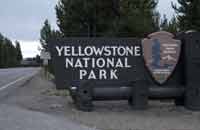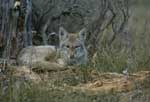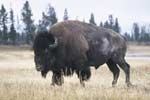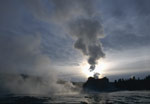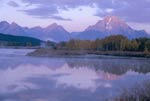| Getting There! | |
| An e-mail from Wildshots offering
a late discount for a photographic trip to Yellowstone and the Grand Tetons had started
me, Phil, on a seemingly never ending journey through a very long day. It started at
2.00am in the Forest of Dean so I could catch a coach from Chepstow to London Gatwick, a
journey of nearly 3 hours in itself . The 8 hour flight to Cincinnati was followed
by a 4 hour flight to Salt Lake City, on which there was no food. I thought in America
food was always available! A one hour flight to Bozeman, Montana and a 2 hour drive in our
spacious vehicles finally saw the 12 weary travellers hit the sack in Gardiner, near the
north entrance to Yellowstone Park, about 24 hours after I had left the Forest of Dean!
Still a nights sleep soon restored the group to some sort of sanity even if we all kept
nodding off and waking up at strange hours.
|
|
| Yellowstone | |
|
|
Much information is available on what is the
worlds first National Park (yellowstone-natl-park
is a good place to start) so I will not dwell on the theory and history but will
concentrate on the photography. Most if not all my photographs were taken from close to
the vehicle. Hides were certainly not required although a quiet approach was needed for
most of the wildlife and especially the birds. Elk in Mammoth were particularly
approachable and Coyotes would come to the vehicles looking for food. Feeding them is
forbidden but some people were still feeding them biscuits. Much as we all deplored this
practice we used the opportunities to take pictures, certainly a case of double standards!
Pronghorn Antelope were reasonably common between Gardiner and Mammoth whilst Longhorn
sheep were seen in the same area but only distant shots were
obtained.
Click here to show more Coyote and Pronghorn images Our visit coincided with the Elk rut and the Bulls needed to be treated with caution. Certainly getting between the Bull and his harem was definitely a no-no. One Bull at Norris was particularly aggressive and we were greeted on arrival by the sight of the Bull and a too ambitious photographer playing ring-a-ring-a-roses around a tree. The Bull only retreating when his females started wandering off. I'm not sure of the truth of the story but the Bull had allegedly put his antlers through a car door the previous week! Many of the Bulls with small harems were not bothered by people and allowed close, down to 20 yards, approach. Our biggest problem seemed to be choosing the right size lens for each opportunity. Taking a big lens for Elk some distance away usually meant they would come very close so only head shots were possible while taking a small lens meant the Elk would walk away! Still Elk were ever present so over the two weeks we were bound to get it right, eventually.
Click here to show more Elk images Bison would also allow you to get close to them but we found the best way, as they were mostly always on the move, was to anticipate where they going and to get in position. However, Bulls needed to be treated with care as there had been reports of visitors getting too close and being attacked. Along the Madison River we came across 3 herds all trying to cross the river at the same time. Bulls were getting very jumpy and started dust bathing and charging each other, as we had got out of the van and were in the middle of them, I was certainly concerned having only a very thin fence between me and a very large Bull! It certainly got the adrenaline running but isn't to be recommended to anybody with a nervous disposition. I had my eye on a car on the road with the window open as an escape route although I think the Bison would have caught me before I could dive through the window.
Click here to show more Bison images Birds were much scarcer, especially for photography, and reasonable pictures were only obtained of the Trumpeter Swans, the best place being the Madison River. I seemed to forget to take pictures of the ever present Canada Geese! Other people on the trip managed pictures of the Grey Jays but I was having a time-out when they came down to bait and there were reasonably tame Ravens around Old Faithful Hotel car park. The Geysers around the Old Faithful Hotel were spectacular and were worth the visit by themselves. Old Faithful while being predictable (it erupts every 65 mins or so) was not the best spectacle. For me Castle Geyser was the best but if you are into Geysers there must surely be one here that takes your fancy! Obviously sunrise and sunset are the best times for photography and in September we didn't have to get up too early. Unfortunately our second day and last day at Old Faithful was cloudy.
|
| GRAND TETONS | |
| The Grand Tetons must be one of the best
places for scenery pictures in the USA. Ox Bow Bend was breathtaking at dawn with the only
problem being finding a place amongst the assembled photographers that didn't get in
anybody's view through their viewfinder! Most photographers seemed to leave straight after
the sun rose but as the lighting was constantly changing it is worth staying well after
sun rise. I had never seen Autumn colours quite like those on the trees in the Grand Tetons although as there was still many trees with green leaves it looked like it could only get better. For 'tree' photographers it must have been heaven and even I took lots of tree pictures.
Click here to show more landscape and tree images We were unlucky with Moose, only coming across one family group when the weather was very dark, but still providing reasonable photographic opportunities. Trumpeter Swans and Ducks were seen and photographed just outside of Jackson Hole near the visitor centre and Bison were also about. Elk had not yet started visiting the refuge as they do in their thousands during the winter. The photographic galleries in Jackson Hole are a must see if only to look at the pictures of Great Grey Owl I dream about! |
|
| Equipment and Tips | |
| A wide range of lenses are required to do
justice to such a fantastic area. Ideally you need the full range from a wide angle to
500mm with converters although the 500mm was a bit of a luxury that isn't essential. My
favourite lens was the 100-400mm zoom. A tripod is also essential for the landscapes along
with the usual filters. It was also useful for many of the wildlife shots even with IS
lenses although I did have to go without for a day as I left it at Jackson Hole after
photographing the Trumpeter Swans! Thanks to Jeff for taking the trouble for retrieving it
and returning it to me. As usual get out early and stay out late, you can sleep and eat when it is pitch dark! Take lots of film although a digital camera looks more and more tempting. If you are in a group look at what other people are doing. Be watchful of the wildlife, they are wild and not in a zoo. Try to get something different with backlighting, action etc and experiment. Get down to wildlife level by lying on the floor for example. Use different lenses on the same subject. Have your camera ready at all times. Go there at least once, preferably more. |
|
